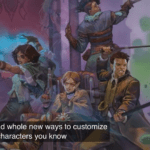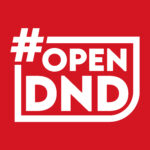WotC’s PHB 2024: Hit or Miss on Disability & Diversity?

How exciting! Take a look at that screenshot from the preview video for the Dungeons & Dragons 2024 Players Handbook (PHB)! They’re showing a picture of a character in a wheelchair and talking about new ways to customize your character!
I told my family and friends. I said, when we launched Limitless Heroics, that this is a movement, that we’re showing the industry that people care about disability, neurodiversity, and mental illness representation. Wizards of the Coast (WotC) hired a fantastic consultant to talk to them about the importance of authentic representation. They showed us what was coming in that video. Even if our work wasn’t an impetus for this change, it’s a Divine Smite against ableism!
So I talked to some of my friends who got advance copies and asked them how the 2024 PHB handled disability inclusion! “There’s nothing there.” Is there maybe a wheelchair in the equipment section?! “No, nothing like that.”
Really?
Today, I looked for myself to see whether they missed something. I searched the D&D Beyond version for anything that might reveal an overlooked section. Nothing. That video was poorly planned at best and completely misleading at worst.
Roll for Racism
But it doesn’t stop there. Because WotC (admirably) wanted to remove terms like half-elf and half-orc due to problematic racist connotations, they removed all rules for creating any character of mixed ancestry. They could have included an adapted variation of the custom lineages from Tasha’s Cauldron of Everything as a paragraph or two instead, but they didn’t, so the 2024 core rules allow only pureblood people groups, effectively gamifying miscegenation laws.
Then, by refusing to follow the distinction between biology and culture as begun with the excellent Ancestry and Culture that nearly every 5e variant since has emulated, they doubled down on the bioessentialism that they attempted to avoid. Contrast that with PJ Coffey’s excellent Homebrew and Hacking: Crafting Heritages and Cultures, which not only offers an infinite variety while distinguishing between biology and culture but also offers a Creative Commons licensed SRD including a digital braille version for accessibility!
GM: “A Hadozee and Tanis Pureblood-Elven walk into the tavern….”
OK, but what about neurodivergence?
Neurodiversity gets even less authentic representation than physical disabilities in games and other media, but WotC showed their (one-time) commitment to this by introducing Asteria in the Book of Many Things, their first autistic character. But sadly, their ADHD representation wasn’t as accurate.
With ability scores, the PHB suggests, “Once you’ve assigned your ability scores, give some thought to what those scores might say about your character’s appearance and personality.” It includes suggestions for high and low scores, but the only remotely neurodivergent trait included, “Fidgety,” is listed under High Dexterity. I can tell you as a fidgety guy with ADHD, Dexterity is my dump stat. Clumsiness is a common trait for ADHD, so if that was an attempt at subtle inclusion, they did not hit the necessary DC for a success.
But not a critical fail
That said, they did make some improvements.

Artwork copyright Kii W – https://twitter.com/kiichan – used with permission.
The artwork includes a vast range of demographics, showing far more diversity than ever, although still no body differences like face differences, body proportion differences, or pigmentation varieties such as vitiligo. The inclusion of disabled characters in the artwork is commendable, even if it’s a picture that lacks 1000 words that should explain them.
Common Sign Language has been added to the common languages list.
The physical version has a larger font for better readability than before but still no braille, not even electronic braille, even though WotC promised this back in 2020.
The Best Improvement
But if I could get them to include one subtle change, one Limited Wish, it would be the inclusion of this sentence, which does appear in the 2024 PHB:
Many effects impose a condition, a temporary state that alters the recipient’s capabilities.
Conditions like Blinded, Deafened, and Paralyzed have often been used to represent the permanent experiences of blindness, deafness, and paralysis, but we have argued that conditions in 5e, in spite of the problematic images in the 2014 PHB (Thanks for removing those!), are designed to represent temporary circumstances, not the permanent disabilities we encounter and experience in the real world. WotC finally codified that.
This is a critical inclusion. This clarifies that disabilities are more complex than rolling with disadvantage. It hints that disabilities are nonbinary spectrums. It removes the insinuation that people can’t learn to adapt to their disabilities and even thrive with them.
Yeah, I’m probably reading too much into that, but we’ll take our victories where we can get them and use them to ascend yet another step in an inaccessible world.
We are still in Initiative, and it’s our turn.
